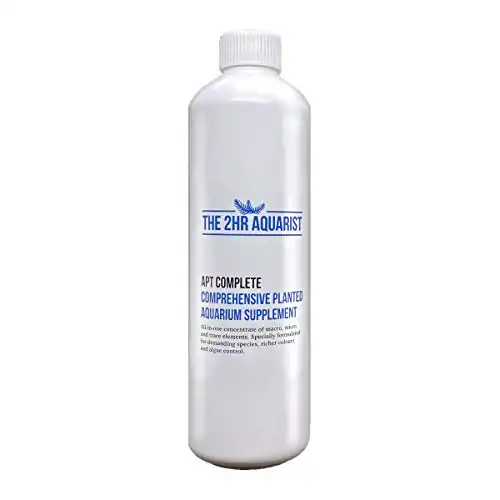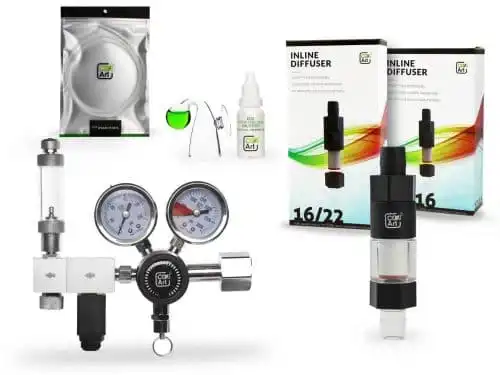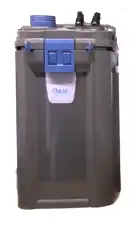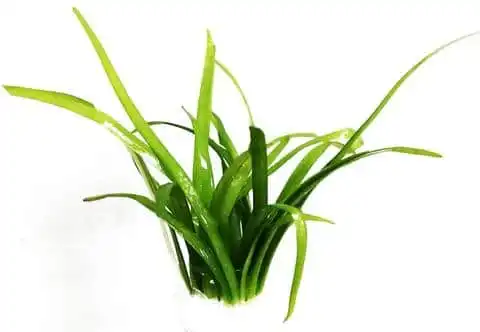Thank you for visiting! By the way… any links on this page that lead to products on Amazon and other stores/partners are affiliate links Aquarium Store Depot earns a commission if you make a purchase.
Dwarf Sagittaria, Sagittaria subulata, is one of those great aquarium plants that have a place in just about any aquarium. Today’s post is all about Dwarf Sagittaria care and how to make it thrive in your aquarium. This hardy plant is easy to care for and great for beginners looking to green up their tanks without spending too much on equipment and fertilizers.
At the same time, more experienced aquarists appreciate the versatility of this plant and the beautiful carpet effect that can be created in the aquascape. Read on to learn how to grow and care for this popular plant!
A Brief Overview Of Dwarf Sagittaria
| Scientific Name | Sagittaria subulata, Sagittaria pusilla |
| Common Names | Dwarf Sagittaria, Dwarf Sag, Hudson Sagittaria, Awl-leaf, Awl-leaf Arrowhead |
| Family | Alismataceae |
| Origin | South America and the eastern United States, has become invasive in Great Britain |
| Skill Level | Easy |
| Lighting | Moderate-high, 60-150+ PAR (Umols) |
| Tank Placement | Foreground, Mid ground, Background |
| Flow Rate | Low, Moderate, high |
| Temperature Range | 70 – 82°F |
| Height | 4 – 12 inches |
| pH Range | 6.0 – 8.0 |
| Proprogation | Runners |
| Growth Rate | Moderate/ Fast |
| Feed Type | Root Feeder |
| Co2 Requirement | No, but recommended |
Origins And Habitat
Dwarf Sagittaria is native to the eastern United States of America and parts of South America like Colombia. In nature, it is essentially a marsh plant of coastal areas where it grows both emersed and fully submerged in brackish and freshwater environments.
Unfortunately, Sagittaria subulata has become an invasive species in some parts of the world, including Great Britain1. Remember to be very careful about disposing of any aquatic plant. Even trimmings can take root if they get into your local waterways.
What Does Dwarf Sagittaria Look Like?
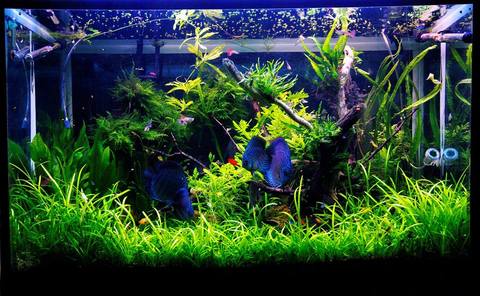
Dwarf Sagittaria is a green rosette plant that looks a lot like a wide-bladed grass. It gets this grass-like look from its long and flattened leaves that measure just 0.2 inches or so across.
Sagittaria subulata is a flowering plant, and emersed specimens will grow small white flowers if they are grown in ideal conditions. Some aquarists have even managed to get this plant to flower in their home aquariums.
Dwarf Sagittaria is pretty variable in size, depending on factors like nutrient and light availability. The leaves can grow up to a foot tall, but mostly this is a small plant that stays below about 6 inches. They develop a pretty extensive white root system in the substrate, that can often be seen up against the glass in your tank.
Placement And Lighting
Dwarf Sagittaria is a pretty versatile plant that works well in many different aquascape styles. As a carpeting plant, it is an ideal species for beautiful Iwagumi aquascapes.
Depending on the conditions in your tank, Sagittaria subulata can be small enough to grow as a foreground plant, but it is usually better in the mid-ground. It looks great when planted in groups.
Dwarf Sagittarias spaced close together will crowd each other for a dense and interesting effect. In nano tanks, taller specimens can even be used as a background plant. In time, and under decent light, this plant will spread by runners to create a great carpet effect in the aquascape.
Dwarf Sagittaria doesn’t need high lighting, and decent LED lights are perfectly fine. They will do better under good fluorescent lights though and develop better color in a brighter tank, often developing hints of red on the leaves. If you are planning to use them in an Iwagumi, you should plan on at least moderate lighting with CO2 to keep algae at bay.
They also tend to grow more low and compact under higher light, not needing to ‘reach up’ to photosynthesize.
What Are Good Tank Mates?
Dwarf Sagittaria is an excellent tank mate for most species of tropical freshwater fish. Sagittaria subulata is very useful in that it provides a perfect habitat for bottom feeders to forage in, while also creating a great place for spawning fish to deposit their eggs. It also makes a good place for small fry and shrimps to escape potential predators.
This fast-growing plant is also very helpful for soaking up excess nutrients from fish waste and food that can become toxic for your fish and inverts.
Good Tank Mates
The list of good tank mates for Dwarf Sagittaria would be a pretty long one, but the following are a couple of great choices:
- Betta Fish
- Shrimp
- Snails
- Certain Barbs – like Cherry Barbs
- Tetras
- Corydoras
- Danios
- Livebearers
- Rasboras
- Otos
Fish Species To Avoid
Unfortunately, some types of fish just don’t get along with Dwarf sags, or other aquatic plants in general. Avoid keeping large cichlid species like oscars with this plant because their love for digging and this plant’s need to stay rooted don’t make a good combination.
Plant-eating fish like goldfish should also be avoided because they will feed on the leaves of this species.
Feeding (Fertilization)
Dwarf Sagittaria does not need fertilizer if grown under low-tech conditions. If, however, you plan on growing this plant to its best potential under good lighting, and with CO2, a nutrient-rich substrate will be necessary. That is because dwarf sags are a root-feeding plant species that gather their nutrients from the substrate.
The best way to provide nutrients to Sagittaria subulata is to grow them in good quality, enriched aquarium soil like Eco-complete or ADA Soils. Another great option is to provide your sagittarias with root tabs. Root tabs are capsules of a fertilizer that dissolves in the substrate, providing a slow release of nutrients to the plant’s roots, right where they are needed.
Root tabs are usually only necessary for inert (without nutrients) substrates like gravel, but they can also be great for topping up old, leached-out aquarium soil. Liquid fertilizers also work well when used with active soils like ADA. For a liquid Fertilizer, check out APT complete.
Editor's Choice
Made by an aquascaper for aquascapers. This is the best all around aquarium plant fertilizer on the market. Marco and micronutrients in one bottle!
Use Coupon Code ASDComplete for 10% off your order!
If you plan on growing a Dwarf Sagittaria carpet, it is much more practical to start out with an enriched aquarium soil, that way you know that there are plenty of nutrients available for the plant to spread across the bottom of your tank.
Dosing a liquid iron supplement like Seachem Flourish Iron in the water column can be very useful since the Dwarf Sagittaria is known to suffer from an iron deficiency in many home aquariums.
How Much And How Often To Feed
Root tabs usually last for a few months before they need to be replaced, but that will depend on how fast the plant is growing, and the specs of the root tab you use. Root tabs only need to be placed around the root zone.
CO2 Injection
While Dwarf Sagittaria can definitely be grown successfully without CO2 injection, this plant will thrive under improved conditions with good lighting and increased carbon dioxide. If you don’t already have a CO2 system, you don’t need to rush out and put one together to keep this plant happy though.
If you are running carbon dioxide, be sure to keep your levels to a maximum of 30ppm and set your system to run from about 2 hours before your lights go on, and then switch off at the same time as the lights. If you are looking for a high quality CO2 system, check out brands like CO2 art. You can develop a dense carpet with CO2 injection.
Use Offer Code ASD10%Off
The highest end offering by CO2Art. This package includes everything you need to perform consistent and the highest quality CO2 injection in the industry!
Types
- Tall Narrowleaf Sagittaria – This form of Dwarf Sagittaria grows taller than the regular variety of Sagittaria subulata, reaching a height of about 20 inches.
- Broad-leaf Sagittaria – This Sagittaria is actually a different species to the Dwarf Sagittaria. It is correctly known as Sagittaria platyphylla. This species grows to a larger size but has much the same care needs as regular Dwarf Sagittaria.
Care
Dwarf Sagittaria is easy to care for and will grow well without much effort from the aquarist. Some trimming and pruning will encourage lateral growth and runners, which is ideal if you’re trying to achieve a Dwarf Sagittaria carpet.
Unfortunately, trimmed Dwarf Sagittaria leaves will often melt back and die, so it often works out better to trim off the longer leaves completely from their base. You may also want to remove runners as they appear to keep this plant contained where you want it.
Planted Tank Parameters
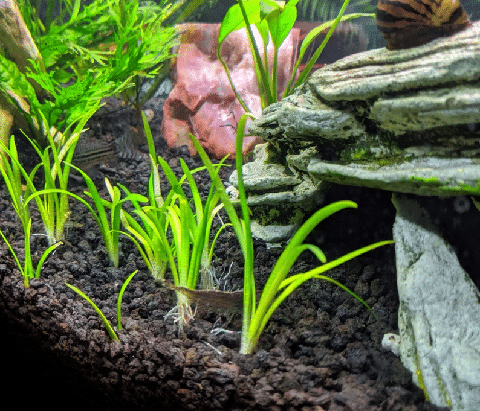
Dwarf Sagittaria (picture source) does well in a wide range of parameters from soft to hard water (2-15GH). It is a hardy plant that grows well under a variety of conditions and pHs but will do best in fairly neutral conditions from about 6-8. The preferred water temperature range is between 70 and 82°F. If you are planning to keep fish that require a higher temperature like Betta or Discus fish, consider getting an aquarium heater.
Water Quality
Maintaining good water quality will benefit all the plant and animal species in your aquarium. One downside to growing a spreading carpeting plant like Dwarf Sagittaria is the potential for fish waste and uneaten food to settle between the leaves of the plant.
This waste can then decompose, causing nasty spikes in ammonia and nitrites. The best way to avoid this pitfall is to perform regular partial water changes and keep a lightly stocked aquarium, making sure not to overfeed your fish.
Filtration
Good filtration is one of the cornerstones of any healthy planted tank. Apart from filtering the system of physical waste particles and impurities, filters also clean the system of biological toxins that can be harmful to your aquatic plants and livestock.
In reality, it is the beneficial bacteria that form colonies inside your filter media that perform this function. These bacteria convert harmful chemicals into harmless compounds through a process known as biological filtration.
Dwarf Sagittaria has no special filtration needs, per se, but as a general rule, the aquarist should select a filter that will process the volume of their tanks 4-6 times every hour. In a planted aquarium, plants will generate more ammonia than your fish, due to this it is best to step up your filtration.
Planted aquariums with aquascapes and aquascaping styles should consider a high quality filtration unit like a canister filter. The addition bio-capacity will keep ammonia in check and the added flow rate will help with flow. The OASE brand has my highest recommendation.
The Pro's Choice
The top choice among professional aquascapers. German engineering and equipped with an intregrated heater.
Flow
Dwarf Sagittaria is a hardy plant that grows from a strong set of roots. This makes this species quite comfortable in a range of different current strengths once established in the substrate.
If you are concerned about the flow in your aquarium being too strong, you can slow the flow by directing the filter’s outlet towards the surface of the tank or against a hardscape feature in the tank to break up the current.
Aquarium Maintenance
As mentioned, carpeting species like Dwarf Sagittaria can act as a trap for waste at the bottom of your tank. One important part of maintenance is to vacuum over the plant with your gravel vacuum to remove as much waste as possible from between the leaves. It is best to do this during your weekly water change when you need to remove water from the aquarium anyway.
Testing Water Conditions
The best way to monitor the health of the system in your aquarium is through regular testing. This gives you the chance to pick up any potential water quality issues before they can affect your plants and animals.
The aquarist should test the water they are going to be using in the aquarium before stocking with any plant or fish species. This will give you an idea of the parameters of your local water and help you decide which species are likely to thrive in your tank.
Water conditions also naturally deteriorate in the home aquarium as waste builds up and that’s why it’s so important to perform regular partial water changes. Go ahead and test your parameters with a liquid test kit just before performing a water change to figure out if you’re doing frequent enough, and big enough changes.
How To Set Up Your Aquarium Tank
Dwarf Sagittaria is a plant without any special tank requirements. The most important factor for success if you want to grow Dwarf Sagittaria is to provide it with a layer of substrate to root in. Add 2-3 inches of good quality aquarium soil, coarse sand, or fine gravel.
The size of your tank isn’t too important because Sagittaria subulata can be grown in just about any tank size, from just a few gallons and up. Of course, if the depth of your aquarium is lower than the maximum size of the plant, it may need to be trimmed or it will grow up above the water’s surface.
How To Propagate
Dwarf Sagittaria propagates very easily. A healthy plant will send out runners that spread themselves around the tank.
These plantlets can be removed and replanted within the tank or in another aquarium. If you do plan on pinching off young plantlets to replant, wait until they have developed some healthy roots of their own. Here is a good video by Pat’s Fish Tanks that shows how to propagate this plant. Check it out below.
Health And Disease
Dwarf Sagittaria is a plant that usually grows really well, without any major health or disease problems. This hardy species can be prone to a few minor issues, however. Let’s take a brief look at what to look out for and how to manage these issues.
Signs Of Good Health
A healthy Sagittaria subulata specimen will have bright green leaves and a well-developed system of white roots.
Signs Of Poor Health
Plants with yellow, brown, or otherwise discolored leaves are in poor health. Avoid plants that are obviously infested with pests and plants that do not have a healthy root system. Melting, transparent leaves are also a sign of a plant that is not in good health.
Common Health Issues And Treatment
One of the most commonly reported problems in Sagittaria subulata is an iron deficiency. The most obvious symptom of iron deficiencies is chlorosis (yellowing leaves). If you notice this happening, use an iron supplement like Seachem Flourish Iron to meet the plant’s needs.
Another potential problem with Dwarf Sagittaria is leaf melt. Melt is a common condition that affects all sorts of different aquarium species. This typically happens when plants go into shock after being planted in a tank with very different environmental parameters to what they are used to.
It can be pretty alarming to see the leaves die off and decay, but plants usually recover well and sprout new leaves. Don’t panic if this happens to your Dwarf Sagittaria, just be sure to remove any dying leaves before they can spoil and decay in your aquarium.
Melt can also happen if your plants are set too deep in the substrate, so be sure to keep the crown of your Dwarf Sagittaria above the surface of the substrate when first planting.
Plant Pests
Plant pests and unwanted inverts often find their way into home aquariums on new plants. Before planting a new species in your tank, take the time to carefully inspect your plants and remove any pests you can find.
Sagittaria subulata can be bleach dipped to kill off any unwanted pests. Prepare a solution of 20 parts water to 1 part bleach and dip your Dwarf Sagittaria in the mixture for about 90 seconds. After dipping, rinse your plant carefully in conditioned water before adding it to your aquarium.
Alternatively, this species can be purchased as a tissue culture specimen that has been raised in a pest-free environment. These specimens come at a slightly higher price, but it’s a fair compromise for healthy, pest-free leaves.
Where To Buy
Dwarf Sagittaria is one of the more popular species in the aquarium hobby and it is usually quite easy to find at your local aquarium and pet stores. A more convenient way to get new plants is to order them online from well-trusted retailers. Online retailers will often have tissue culture varieties available, which will guarantee you a pest free specimen.
A great first time beginner plant. Hardy and thrives in low light. Provides a natural looking ground cover
FAQS
Do they need CO2?
Dwarf Sagittaria doesn’t need added carbon dioxide and is easy to grow in low-tech planted tanks. It responds well to carbon dioxide injection though, and this is definitely recommended for plants that are planted in a nutrient-rich substrate and grown under high light.
Are they easy to grow?
Dwarf Sagittaria is a plant that is very easy to grow and care for, which makes it ideal for beginner aquarists. As long as you provide this plant with the substrate that it needs, and the right parameters, you should have no problem growing this species.
How tall do they get?
Dwarf Sagittaria can be pretty variable in size. This plant can grow to about 12 inches tall, although many specimens stay shorter than that.
Do they need root tabs?
Dwarf Sagittaria doesn’t need root tabs but it will need the extra nutrients if it is grown under stronger light and with added carbon dioxide.
Do they need substrate?
Dwarf Sagittaria needs a good layer of substrate because it is a root-feeding plant that sends roots down into the soil and spreads by runners.
Closing Thoughts
It is easy to see why the Dwarf Sagittaria, Sagittaria subulata, is such a popular plant in the planted aquarium hobby. This easy, low-maintenance plant grows well in almost any tank size, and a variety of parameters, while providing many benefits for its tankmates.
For beginners or anyone looking for a new carpet plant or something interesting for the midground of your aquarium, look no further, Dwarf Sagittarius is probably the ideal choice.
- About the Author
- Latest Posts
I’m thrilled that you found Aquarium Store Depot! Here you’ll find information on fish, aquariums, and all things aquatics related. I’m a hobbyist (being doing this since I was 11) and here to help other hobbyists thrive with their aquariums! I adhere to a high quality Editorial Process and Review products with real life field usage and practical analysis.


